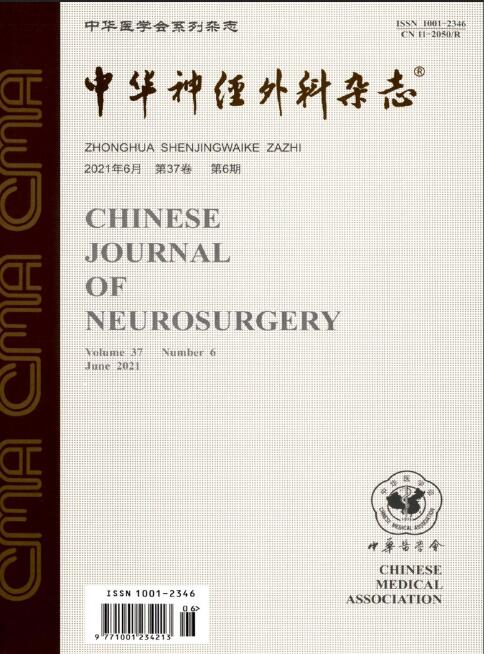Anatomical characteristics of posterior cranial fossa and surgical outcomes in patients with Chiari I malformation
Q4 Medicine
引用次数: 0
Abstract
Objective To discuss the anatomical characteristics of posterior cranial fossa and surgical outcomes in patients with Chiari Ⅰ malformation. Methods Thirty-eight patients diagnosed with Chiari I malformation were admitted to Department of Neurosurgery, General Hospital of Tianjin Medical University from January 2015 to December 2017 and retrospectively enrolled into the patient group of this study, whose clinical data were compared with those of 30 radiologically healthy persons (as controls) admitted to physical examination center of the same hospital during the same period. Two groups of people underwent cervical MRI scan and 3D reconstruction. Clivus length, Mcrae line, Twing line, length of squamousal part of occipital bone, basal angle, Boogard angle, cerebellar volume (CV), posterior cranial fossa volume (PV) and ratio of CV/PV were measured and their anatomical differences were compared between 2 groups according to volume analysis software. Thirty-seven patients were treated with posterior cranial fossa decompression and C1 laminectomy in patient group, and the remaining 1 patient did not undergo relevant treatment. All patients underwent follow-up in outpatient department, an imaging review of cranial-cervical junction MRI and assessment based on cervical Japanese Orthopaedic Association (JOA) scale to assess the improvement of syringomyelia-related symptoms. The outcomes were classified into excellent, good, stable and poor. Results There was no significant difference in age or gender (P>0.05). Compared with healthy control group, PV was decreased (170.7±10.7 mm3vs. 186.8±9.8 mm3), ratio of CV/PV was increased 0.755±0.042 vs. 0.682±0.036, clivus length was shortened (3.9±0.3 mm vs. 4.4±0.3 mm), and Boogard angle was increased (124.2±8.2° vs. 116.6±3.6°) in the patient group (all P 0.05). All 37 patients underwent successful operation. There were no cases of new neurological deficits or death after operation. At 12 weeks post surgery, the JOA score was improved compared with preoperative conditions (15.20±2.36 points vs.11.71±2.92 points. P<0.05). The follow-up duration of 37 patients was 15.2 ± 6.8 months and ranged from 6 to 30 months. At the last follow-up, the improvement rate of syringomyelia-related symptoms was 69.9±29.0%. The outcomes were determined as excellent in 20 (54.1%) patients, good in 11 (29.7%) and stable in 6 (16.2%). Conclusions The decrease of posterior fossa volume and increase of ratio of cerebellar volume and posterior cranial fossa volume could be important factors in Chiari Ⅰ malformation contributing to cerebellar tonsillar herniation. The surgery of posterior fossa decompression could effectively improve clinical symptoms. Key words: Arnold-Chiari malformation; Cranial fossa, posterior; Anatomy; Neurosurgical procedures; Treatment outcomeChiari I型畸形患者后颅窝解剖特征及手术效果
目的探讨ChiariⅠ畸形后颅窝的解剖特点及手术治疗效果。方法2015年1月至2017年12月,天津医科大学总医院神经外科收治38例Chiari I畸形患者,将其临床数据与同期入住同一医院体检中心的30名放射学健康人(作为对照)的临床数据进行比较。两组患者接受了颈部MRI扫描和3D重建。根据体积分析软件,测量两组的斜坡长度、Mcrae线、Twing线、枕骨鳞片部长度、基底角、Boogard角、小脑体积(CV)、后颅窝体积(PV)和CV/PV比值,并比较两组的解剖学差异。患者组37例接受后颅窝减压和C1椎板切除术治疗,其余1例未接受相关治疗。所有患者都在门诊接受了随访,对颅颈交界处MRI进行了影像学检查,并根据日本颈椎骨科协会(JOA)量表进行了评估,以评估脊髓空洞症相关症状的改善情况。结果分为优秀、良好、稳定和较差。结果与健康对照组相比,PV降低(170.7±10.7 mm3 vs.186.8±9.8 mm3),CV/PV比值增加0.755±0.042 vs.0.682±0.036,斜坡长度缩短(3.9±0.3 mm vs.4.4±0.3 mm),手术组Boogard角增加(124.2±8.2°vs.116.6±3.6°)(均P<0.05)。术后无新的神经功能缺损或死亡病例。术后12周,JOA评分较术前有所改善(15.20±2.36分vs.11.71±2.92分,P<0.05)。37例患者的随访时间为15.2±6.8个月,随访时间为6至30个月。最后一次随访时脊髓空洞症相关症状的改善率为69.9±29.0%,良11例(29.7%),稳定6例(16.2%)。后颅窝减压手术能有效改善临床症状。关键词:Arnold-Chiari畸形;颅窝,后部;解剖学;神经外科手术;治疗结果
本文章由计算机程序翻译,如有差异,请以英文原文为准。
求助全文
约1分钟内获得全文
求助全文
来源期刊

中华神经外科杂志
Medicine-Surgery
CiteScore
0.10
自引率
0.00%
发文量
10706
期刊介绍:
Chinese Journal of Neurosurgery is one of the series of journals organized by the Chinese Medical Association under the supervision of the China Association for Science and Technology. The journal is aimed at neurosurgeons and related researchers, and reports on the leading scientific research results and clinical experience in the field of neurosurgery, as well as the basic theoretical research closely related to neurosurgery.Chinese Journal of Neurosurgery has been included in many famous domestic search organizations, such as China Knowledge Resources Database, China Biomedical Journal Citation Database, Chinese Biomedical Journal Literature Database, China Science Citation Database, China Biomedical Literature Database, China Science and Technology Paper Citation Statistical Analysis Database, and China Science and Technology Journal Full Text Database, Wanfang Data Database of Medical Journals, etc.
 求助内容:
求助内容: 应助结果提醒方式:
应助结果提醒方式:


